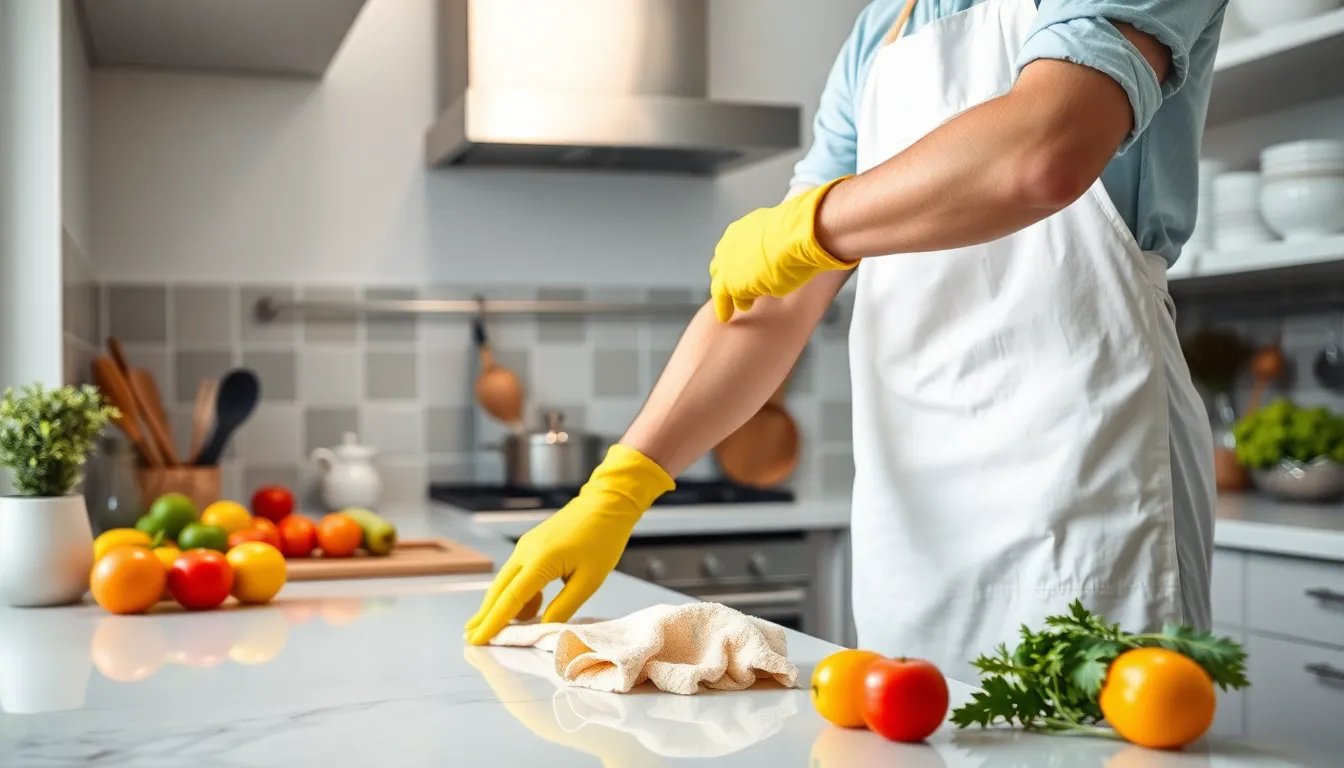A clean kitchen is essential for maintaining health and preventing foodborne illnesses. With the hustle and bustle of daily cooking, it’s easy to overlook some crucial hygiene practices. However, a few simple tips can make a significant difference in keeping the kitchen safe and sanitary.
From proper food storage to effective cleaning techniques, understanding kitchen hygiene is vital for everyone who enjoys cooking. Implementing these practices not only protects loved ones but also enhances the overall cooking experience. Discovering how to maintain a spotless kitchen can transform meal prep into a more enjoyable and worry-free activity.
Importance Of Kitchen Hygiene
Maintaining kitchen hygiene is vital for health and safety. It not only fosters a clean cooking environment but also enhances the overall cooking experience.
Health Benefits
Proper kitchen hygiene promotes overall health by reducing the risk of infections. A clean countertop and sanitized utensils minimize contamination from harmful bacteria. Regularly washing hands before handling food limits the spread of germs. Cleanliness in the kitchen contributes to improved mental well-being by providing a pleasant cooking atmosphere.
Preventing Foodborne Illnesses
Preventing foodborne illnesses requires consistent hygiene practices. According to the Centers for Disease Control and Prevention (CDC), 48 million people fall sick from foodborne illnesses each year in the U.S. Key practices include keeping raw meats separate from other foods to prevent cross-contamination and cooking food to the appropriate temperatures. Regularly inspecting expiration dates and storing food correctly helps maintain safety and freshness, reducing the likelihood of illness.
Essential Kitchen Hygiene Tips


Maintaining hygiene in the kitchen is crucial for food safety and overall health. Implementing effective practices can significantly decrease the risk of foodborne illnesses.
Cleaning Surfaces
Cleaning surfaces requires regular attention to eliminate bacteria and prevent cross-contamination. Use disinfectant solutions on countertops and cutting boards daily. Wipe down surfaces with a clean cloth or paper towel after food preparation. Clean spills immediately to prevent sticky residues and encourage pests. Use separate cloths for different areas to avoid spreading contaminants.
Proper Food Storage
Proper food storage maintains the safety and quality of ingredients. Store raw meats on the bottom shelf of the refrigerator to prevent drips onto other foods. Seal food items in airtight containers and label them with dates. Keep leftovers in the fridge for no more than three to four days and freeze items that won’t be consumed within this timeframe. Regularly check and remove expired items to avoid consuming unsafe foods.
Hand Hygiene Practices
Hand hygiene practices are essential before and after handling food. Wash hands thoroughly with soap and water for at least 20 seconds after touching raw meat, eggs, or dairy. Use hand sanitizer with at least 60% alcohol when soap isn’t available. Avoid touching the face, hair, or other surfaces during food preparation to eliminate the risk of contamination. Ensure nails are kept short and free from dirt to maintain cleanliness.
Tools And Products For Maintaining Hygiene
Maintaining hygiene in the kitchen requires the right tools and products. Effective cleaning supplies and organizational strategies play a crucial role in promoting food safety and a tidy environment.
Recommended Cleaning Supplies
- Disinfectant Spray: Use a disinfectant spray for surfaces and utensils. Look for products that kill 99.9% of bacteria and viruses, including E. coli and Salmonella.
- Multi-Surface Cleaner: Choose a multi-surface cleaner for versatility. This cleaner works on countertops, tables, and other surfaces to eliminate grease and grime.
- Sponges and Scrubbers: Opt for sponges and scrubbers that are non-abrasive. Change them regularly to prevent bacterial buildup.
- Microfiber Cloths: Select microfiber cloths for dusting and wiping down surfaces. They’re effective at trapping dirt and do not leave lint behind.
- Dish Soap: Use antibacterial dish soap for washing dishes and utensils. Ensure it effectively cuts through grease and food residues.
- Rubber Gloves: Wear rubber gloves while cleaning to protect hands from harsh chemicals. They also prevent cross-contamination.
- Trash Bags: Invest in durable trash bags with odor control features. Replace them often to maintain a clean environment.
Organizing Your Kitchen
- Storage Containers: Utilize airtight storage containers for food items. Clear, labeled containers help monitor expiration dates and maintain freshness.
- Shelving Units: Install shelving units to maximize vertical space. This allows for easy access to ingredients while keeping kitchen essentials organized.
- Drawer Organizers: Use drawer organizers for utensils and gadgets. This prevents clutter and simplifies daily meal preparation.
- Labeling Systems: Implement a labeling system for pantry items. Identifiable labels enhance efficiency during cooking and reduce the chances of using expired items.
- Food Safety Zones: Designate specific areas for raw meats, vegetables, and cooked foods. This organization minimizes the risk of cross-contamination.
- Regular Inventory Checks: Conduct regular inventory checks of pantry items and perishables. Discard expired foods promptly to maintain hygiene and safety.
Common Kitchen Hygiene Mistakes
Maintaining kitchen hygiene requires attention to detail. Several common mistakes can jeopardize health and safety, even when other practices are followed diligently.
Overlooking Appliances
Appliances often accumulate dirt and bacteria if not cleaned regularly. Refrigerators, microwaves, and ovens require consistent attention. Regularly wiping down these surfaces prevents food residue buildup and limits bacterial growth. Cleaning the refrigerator with warm, soapy water every month keeps it sanitized. Microwaves need special attention; covering food during heating prevents spills, while periodic interior cleaning ensures there’s no lingering bacteria. Ovens should be cleaned after spills to maintain hygiene and minimize odors. Addressing appliances prevents cross-contamination and ensures food safety.
Neglecting Utensils
Utensils, including knives, spoons, and cutting boards, can harbor harmful bacteria if neglected. Washing utensils immediately after use with hot, soapy water is essential. Keeping separate cutting boards for raw meats and vegetables minimizes cross-contamination and ensures safety. It’s advisable to regularly replace worn-out utensils, as cracks can trap bacteria. Dishwashers effectively sanitize many utensils, but handwashing remains crucial for wooden and non-dishwasher-safe items. Disinfecting utensils after preparing raw foods ensures clean cooking surfaces for future meal preparation.





